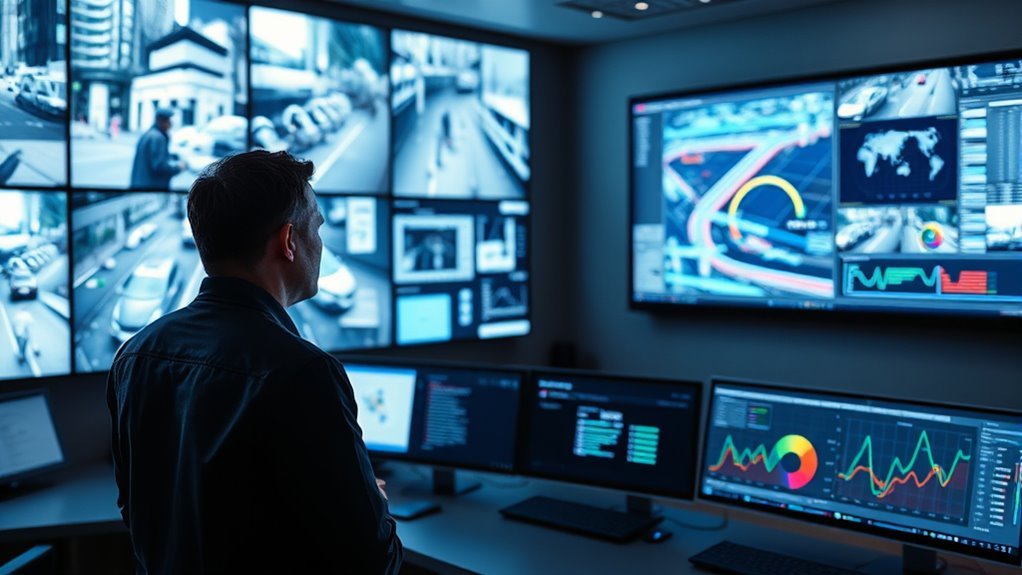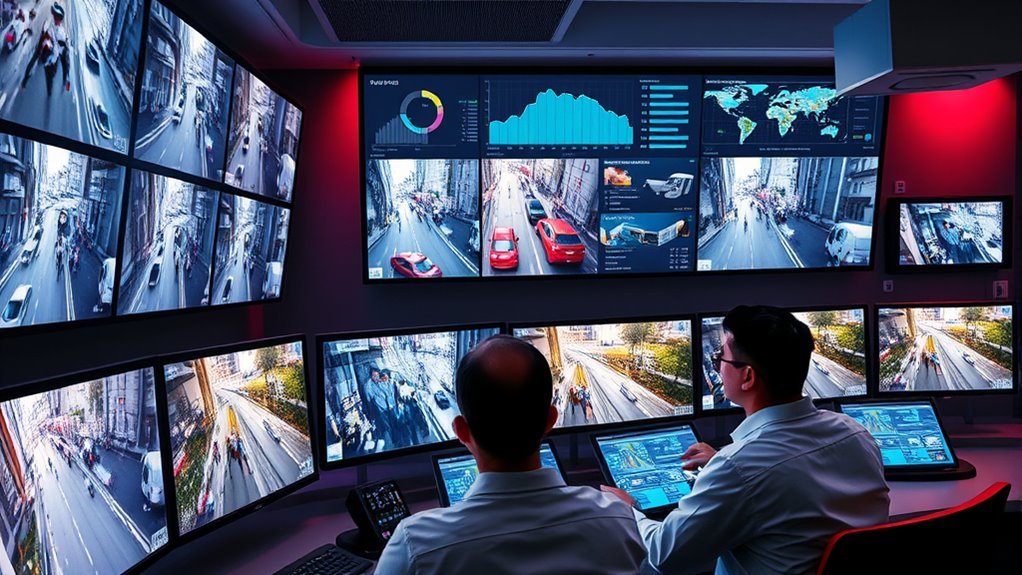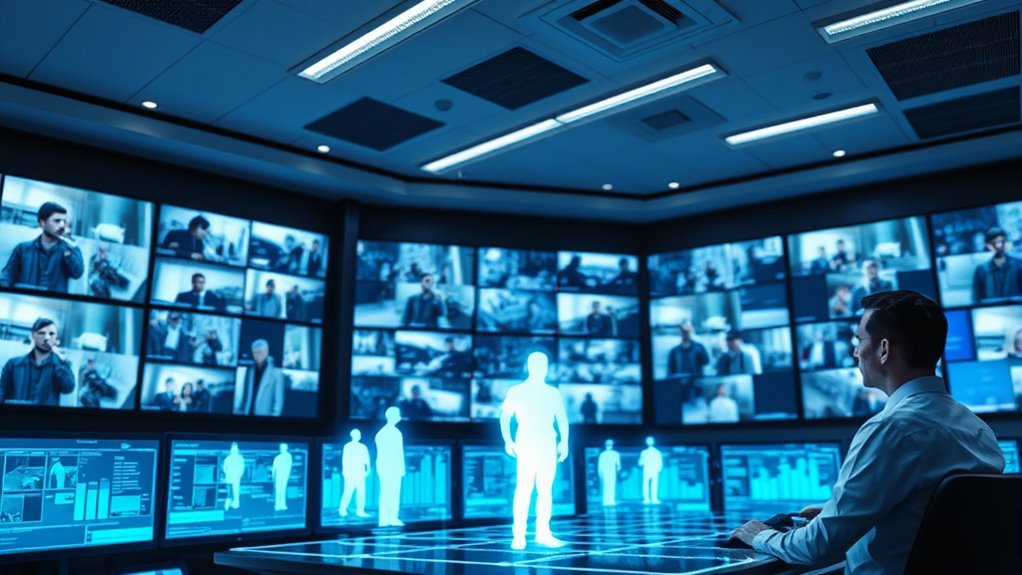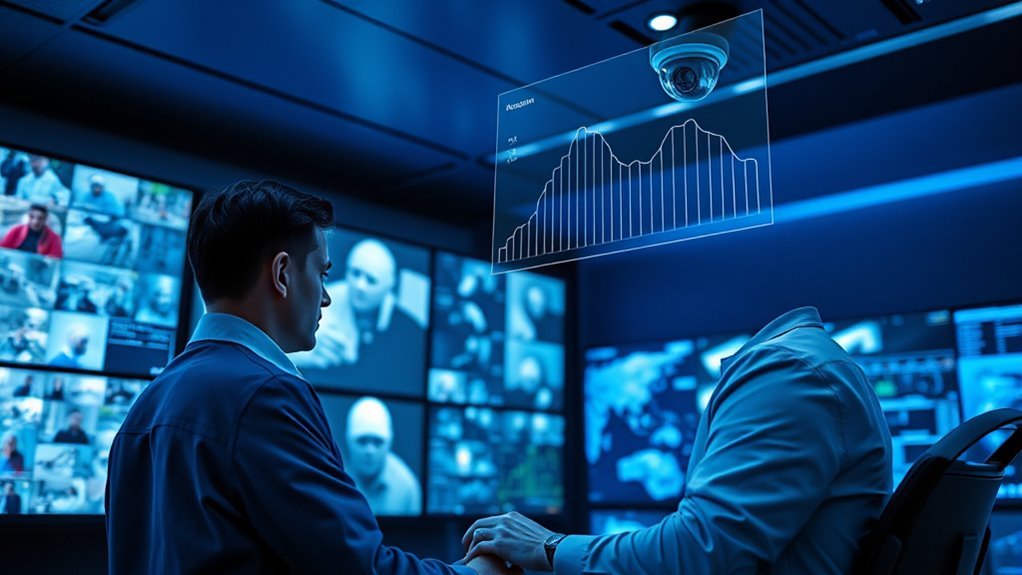If you’re implementing AI for real-time video analytics in security, focus on leveraging computer vision, machine learning, and edge computing to transform live surveillance into proactive threat detection. This tech sharpens accuracy, reduces false alarms, and provides immediate alerts for faster responses. You’ll also need to address data privacy, system integration, and ethical use carefully to maximize trust and compliance. Exploring these elements further will give you a clearer path to a smart, adaptive security solution.
Understanding AI in Video Analytics

Although video surveillance has long been a cornerstone of security, AI transforms it by enabling real-time analysis that goes far beyond passive recording. When you harness machine learning algorithms, you empower systems to detect anomalies and patterns autonomously, freeing you from constant manual monitoring. By leveraging advanced computer vision techniques, these systems interpret complex visual data with precision, identifying threats faster than traditional methods allow. This strategic integration guarantees you gain actionable insights instantly, enhancing situational awareness without sacrificing your operational freedom. Embracing AI in video analytics means you’re not just collecting footage—you’re revealing intelligent, proactive security that adapts and evolves. This shift redefines how you safeguard assets, making security more dynamic, responsive, and ultimately liberating. Effective prompt engineering ensures the AI system interprets visual data accurately, minimizing ambiguity and enhancing real-time threat detection through clear and specific prompts.
Key Technologies Behind Real-Time Video Analysis

When you explore real-time video analysis, you’ll find it relies on a blend of cutting-edge technologies like deep learning, edge computing, and computer vision. These technologies empower you to extract actionable insights instantly, freeing you from delays and manual monitoring. Machine learning models continuously adapt, enhancing detection accuracy and anticipating threats before they escalate. The fusion of these elements creates a resilient, autonomous system that operates seamlessly at the edge.
Key technologies include:
- Computer Vision for precise object and behavior recognition
- Machine Learning to evolve detection capabilities over time
- Edge Computing enabling low-latency processing on-site
- Deep Neural Networks to handle complex pattern analysis
Embracing these tools liberates your security infrastructure, making real-time vigilance both possible and sustainable. Leveraging cloud-based infrastructure ensures scalability and efficiency when deploying these AI-powered video analytics solutions.
Benefits of AI-Powered Video Surveillance

You’ll see how AI-powered video surveillance sharpens threat detection by analyzing patterns faster and more accurately than humans. It also cuts down on false alarms, saving you from unnecessary responses and operational fatigue. Ultimately, this technology lets you allocate resources more efficiently, focusing attention where it matters most. Ensuring transparency and accountability in AI decision-making further enhances the reliability and ethical use of such surveillance systems.
Enhanced Threat Detection
Because AI-powered video surveillance can analyze vast amounts of data instantly, it greatly enhances threat detection capabilities beyond human limitations. You gain a strategic edge by leveraging facial recognition to identify known threats in real time and anomaly detection to spot unusual behaviors before they escalate. This isn’t just technology; it’s your freedom to act decisively.
- Detect potential dangers faster than ever
- Gain continuous situational awareness without fatigue
- Empower proactive security measures instead of reactive responses
- Minimize blind spots with intelligent, adaptive monitoring
With AI, you’re not just watching—you’re anticipating. This visionary approach transforms raw data into actionable intelligence, freeing you from uncertainty and enabling control over your security environment like never before.
Reduced False Alarms
Although traditional surveillance systems often trigger countless false alarms, AI-powered video analytics dramatically cut down these disruptions by accurately distinguishing real threats from benign events. With real time evaluation capabilities, AI continuously analyzes video feeds to assess contextual factors, reducing unnecessary alerts. This precision enhances alarm accuracy, allowing you to focus on genuine security concerns without constant interruptions. By minimizing false positives, you gain freedom from alert fatigue and can allocate your attention strategically. The system’s adaptive algorithms learn from evolving environments, ensuring sustained reliability and responsiveness. Embracing AI means empowering your security infrastructure to operate smarter and more autonomously, safeguarding assets and people while eliminating distractions caused by irrelevant triggers. This shift marks a pivotal step toward a more efficient, intelligent security future.
Efficient Resource Allocation
Cutting down false alarms doesn’t just improve accuracy—it frees up your security team to focus on what really matters. With AI-driven video analytics, you gain unparalleled resource optimization, ensuring every asset is deployed where it’s most effective. This translates into smarter budget management, allowing you to invest in innovation rather than firefighting errors. Imagine having the freedom to:
- Allocate personnel dynamically based on real-time risk assessment
- Reduce overtime costs linked to unnecessary responses
- Redirect funds toward advanced security technologies
- Enhance operational efficiency without expanding your team
Common Use Cases in Security Applications
Five key use cases highlight how AI-driven real-time video analytics transform security operations. You’ll leverage facial recognition to swiftly verify identities, enhancing access control without bottlenecks. Activity detection pinpoints suspicious movements, while crowd monitoring anticipates potential risks in dynamic environments. Vehicle identification tracks unauthorized entries, complementing intrusion alerts that notify you instantly of breaches. Anomaly detection and behavior analysis provide deeper insights, enabling proactive responses before incidents escalate. By integrating these capabilities, you gain unparalleled situational awareness and operational freedom—shifting from reactive to predictive security. These use cases empower you to design resilient, adaptive systems that safeguard assets and people efficiently, all while maintaining seamless flow and privacy. Harnessing AI this way redefines your security strategy, making it smarter, faster, and more autonomous. Additionally, combining these AI capabilities with centralized management optimizes overall security performance across diverse environments.
Steps to Deploy AI Video Analytics Systems
When deploying AI video analytics systems, you’ll need a clear strategy that aligns technology with your security objectives. Your deployment strategies must prioritize seamless system integration to reveal true operational freedom. Start by defining precise security goals and identifying data sources. Next, confirm your AI models are tailored to your environment for maximum accuracy. Then, integrate these models with existing infrastructure to maintain workflow continuity. Finally, establish real-time monitoring and feedback loops to refine system performance continuously.
Align AI deployment with security goals for seamless integration and continuous system refinement.
- Empower your team with intuitive AI tools.
- Gain autonomy through automated, adaptive insights.
- Reduce reliance on manual surveillance.
- Transform raw data into actionable intelligence.
This approach lets you harness AI’s potential while maintaining control and flexibility in your security operations. Additionally, leveraging real-time alerts ensures swift responses to potential security threats within video analytics workflows.
Challenges in Implementing AI for Video Security
You’ll face critical hurdles like safeguarding data privacy while processing vast video streams in real time. Limited processing power can bottleneck your AI’s ability to analyze footage swiftly and accurately. Overcoming these constraints is essential to unleash the full potential of AI-driven video security. Implementing robust encryption methods is vital to protect sensitive data from breaches during transmission and storage.
Data Privacy Concerns
Although AI-driven video analytics offer transformative security capabilities, they also raise significant data privacy concerns that you can’t overlook. Balancing data protection with surveillance ethics is vital to preserving individual freedoms while leveraging AI’s power. You must guarantee transparent data handling to maintain trust and prevent misuse. Without rigorous safeguards, the risk of intrusive monitoring grows exponentially, threatening the very freedoms you aim to protect.
Consider these critical challenges:
- Unauthorized data access undermining privacy rights
- Potential biases in AI misinterpreting behaviors
- Excessive surveillance eroding societal trust
- Compliance complexities with evolving privacy laws
To navigate these, you need strategic frameworks that enforce ethical standards, robust encryption, and continuous auditing—empowering you to harness AI responsibly without compromising personal liberty.
Processing Power Limitations
Since AI-driven video analytics demand immense computational resources, processing power limitations become a critical bottleneck in deploying real-time security solutions. You’ll find that existing hardware limitations restrict how quickly and efficiently AI models can analyze continuous video streams without latency. To break free from these constraints, you need to strategically invest in specialized processing units like GPUs or edge AI accelerators designed to optimize workloads. Balancing cost, energy consumption, and scalability is key to maintaining system freedom without compromising performance. Embracing modular hardware architectures lets you upgrade processing power incrementally, future-proofing your infrastructure. By overcoming these hardware limitations, you empower your security system to deliver instant insights and proactive responses, ensuring your AI-driven video analytics remain both agile and effective in dynamic environments.
Data Privacy and Ethical Considerations
While AI-driven real-time video analytics offer unparalleled security insights, they also raise critical concerns about data privacy and ethical use. You must prioritize data consent, ensuring individuals understand and agree to how their information is captured and analyzed. Implementing robust ethical frameworks is essential to balance security benefits with personal freedoms. Consider these key factors:
- Transparent data collection to build trust
- Minimizing surveillance overreach to protect autonomy
- Secure data storage to prevent unauthorized access
- Accountability measures to govern AI decision-making
Integrating AI Analytics With Existing Security Infrastructure
When you integrate AI-driven analytics into your existing security infrastructure, you reveal the potential to enhance threat detection and response without overhauling current systems. Achieving seamless security integration hinges on ensuring system compatibility; your AI tools must communicate effectively with legacy hardware and software. Focus on modular AI platforms that adapt to diverse protocols and data formats, giving you freedom to scale and evolve. Prioritize interoperability standards and open APIs to avoid vendor lock-in and maintain operational flexibility. By strategically layering AI analytics atop your current setup, you empower real-time insights while preserving your investment. This approach not only accelerates deployment but also future-proofs your security ecosystem, positioning you to leverage AI’s transformative power without disrupting your established framework. Additionally, implementing standardized monitoring frameworks can centralize observability data to enhance analysis and visibility across your security environment.
Future Trends in AI-Driven Video Surveillance
Building on the foundation of integrating AI analytics with your current security infrastructure, it’s clear that the future of video surveillance will be defined by increasingly sophisticated AI capabilities. Future advancements will empower you with predictive analytics and real-time decision making, enabling proactive security measures. Machine learning innovations and deep learning techniques will refine behavioral analysis, making autonomous monitoring more precise and reliable. Edge computing and cloud integration will guarantee smart cameras operate with minimal latency, giving you the freedom to respond instantly.
- Experience unparalleled autonomy with AI-driven monitoring
- Anticipate threats before they materialize through predictive insights
- Leverage smart cameras empowered by edge and cloud synergy
- Gain control through precise, real-time behavioral analysis
These trends will redefine your security landscape, blending intelligence with freedom. The integration of real-time decision support in AI-powered video analytics will allow security teams to act swiftly and accurately based on instant data insights.



